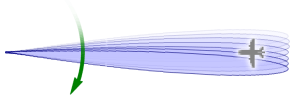Dwell Time and Hits per Scan

Figure 1: the target on the screen is a result of hits

Figure 1: the target on the screen is a result of hits

Figure 1: the target on the screen is a result of hits
Dwell Time and Hits per Scan
Most processes in pulsed radar are time-dependent. Thus, some terms like Dwell Time and Hits per Scan have been established to describe this time-dependence.
Dwell Time
The time that an antenna beam spends on a target is called dwell time TD. The dwell time of a 2D–search radar depends predominantly on
- the antennas horizontally beamwidth ΘAZ and
- the speed of rotation n of the antenna (rotations per minute).
The dwell time can be calculated using the following equation:
| TD = | ΘAZ · 60 | ; in [seconds] | (1) |
| 360° · n |
Hits per Scan
The value of hits per scan m says how many echo signals per single target during every antenna rotation are received. The hit number stands e.g. for a search radar with a rotating antenna for the number of the received echo pulses of a single target per antenna turn. The dwell time TD and the pulse repetition time PRT determine the value of hits per scan.
| m = | TD | = | ΘAZ · 60 | (2) |
| PRT | 360° · n · PRT |
In order to evaluate the target position in radar systems with sufficient accuracy, hit numbers from 1 to 20 are necessary (depending on the working principle of the radar system). The greater the number of hits per scan, the more accurate will be the angle measurement and the better the MTI performance.
For analog displays, the size and brightness of the target character on the screen is also determined by how many hits per scan the target has received. A measurement of the accurate azimuth of the target is still defined herein in the center of the blip on the screen. (The distance is measured at the front edge of this blip.)
Many radares use pulse integration in the radar signal processing to distinguish the target signals from noise and interference pulses. If the number of hits per scan is too small, this target can be suppressed by the increased threshold values because of these disturbances.
In the case of a digital plotextractor, which uses the method of sliding window to determine the azimuth, a predetermined number of hits per scan must also be achieved. A radar with a monopulse antenna requires only one pulse for the accurate azimuth measurement. However, monopulse radars also often require two, three, or more pulses for moving target indication.
Note: The term dwell time does not have a standardized definition. It can also mean the time that a pulse train is hitting the target, or data collection time. By this definition, if multiple PRFs are used while the target is in the beam, then there can be multiple dwells per look.
